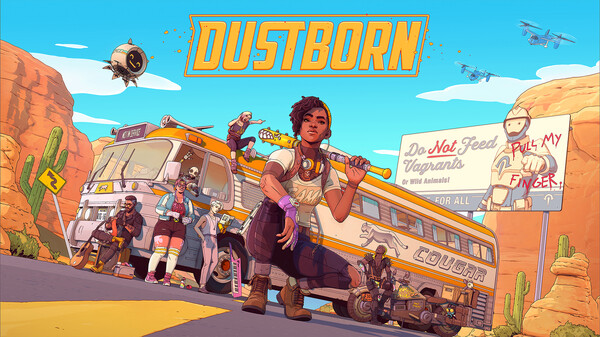Although Dustborn’s almost parodically melodramatic characters and peculiar blend of genres make for an eye-rolling first impression, there is a lot more to it than I initially realized as my group of mutant misfits traveled across America hitting people with an upgraded baseball bat and having emotional conversations. Dustborn is tackling big ideas, and it is doing it with science-fiction squids, biker queens with shattered hearts, and robots wearing bunny hats. This hybrid of rhythm games, comic books, and Telltale-inspired narrative experiences is like a feast of action, story, and genres, and it works better than it should.
You take on the role of Pax, a cold-blooded con artist smuggling superpowered goods to Canada with a group of other smugglers dressed like punk rockers. It takes place in an intriguing parallel history of the United States, one in which Marilyn Monroe is referred to as Lady Justice, JFK was never slain, and a focused blast of information has given some people superhuman abilities. Think more about gaslighting, mind-controlling with your voice, illusion magic, and other techniques rather than laser eyes or flight.
The main focus of Dustborn is for you to make decisions for your character via speech and deeds that lead them to a particular destination on that road journey. Are you going to cuddle up with your ex? Will you share your plan with the rest of the crew? Are you going to listen in on their calls? (Of course, I mean that last one.)
There is action too, in between the adorable talks you have with your allies about mental health that seem like they belong on TikTok with a hashtag. At concerts, your punk songs will transform into timed rhythm games. You can also use a modified handheld device to capture floating objects known as Echos and use it to drag them into position.
Finally, you can use your commanding abilities to confuse, push, or freeze enemies in addition to using a boomerang baseball bat to battle a variety of humans and robots. I always enjoy some button-mashing action packed with music, and even if the battle is straightforward, it looks really good. To break up all the talking, I would have liked more of these sections, but I am likely just easily irritated and emotionally deficient.
In any case, Dustborn’s main weakness is its tempo. This campaign starts slowly, with more explanation than you could eat, and ends with what seems like an interminable stream of angsty dialogue before you can accomplish anything enjoyable with these individuals. It is especially simple to become agitated when it feels like everything you do is making other people angry with you.
There is an emotional reward to all the small talk, and eventually, you find out more about each band member and how to conduct your chats, but initially Pax and the people she is interacting with just appear kind of dumb. It turns out that nothing unites people like bashing robots with a baseball bat in combat sequences or busting out in a band, and I was also won over by it.
You must accept Dustborn in its entirety for it to be worthwhile.
Dustborn requires you to embrace the entire experience to justify your investment, as those action scenes are not the most compelling on their own either. If your primary motivation is music, for example, you will probably become impatient while waiting for your next opportunity to jam out.
Similarly, you can not skip over all the emotional stuff; even if you decide to cut your friends off whenever you can because you do not care about being a stone-cold bitch, you still need to process those choices to go on. I persevered because, well, I love robots and romantic drama, and every time I was about to give up, a subplot in the story would nudge me back in.
Dustborn has made a deliberate effort to be as inclusive as possible, whether it be in the way its problems are handled in dialogue, the way the tale is built up, or the diversity of its characters. As someone who is neither straight nor fully mentally well, I say that it felt performative at first.
However, that concept gradually becomes the motivating factor behind what makes these characters and your decisions toward them far more complex and fascinating. Since the focus of the game is on being unique and integrating into society, the game’s positive message does not interfere with the gameplay experience. Dustborn is accomplishing it with the issues and visual language of 2024, much as the X-Men did in the 1980s.
I was completely engrossed in the story when it found its footing and dared to inject some humor into its occasionally overly serious discourse or to grant you more levels of control. My actions, whether good or bad, were emotionally connected to the dialogue.
Examples included exploring a sinister, robot-filled research lab with my naughty younger sister, achieving a perfect streak during a punk track performance in a small town, shopping for a robot hat in an abandoned mall, and using increasingly bizarre power combinations in combat. I will always remember that time I went on a road trip with some weirdos and set fire to a petrol station, even though I will not be returning for a replay.
Verdict
A few hours later, I was concerned for the well-being of all my little crazy pals as they played gigs, battled robots, and occasionally engaged in melodramatic talks. After the first hour, I was certain that finishing Dustborn would rank right up there with doing laundry in terms of responsibilities. Even though I may have begun by rolling my eyes, by the end I was high on science fiction satisfaction and wondered if I was too old to get a neck tattoo and some neon accessories. Its gang of well-intentioned weirdos presents an engrossing story in an alternate-history America.
